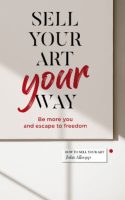With the year we’ve just had, lots of artists’ attention has been on building their online sales, but I ran a poll and around 85% of artists said they still wanted to get into galleries with a massive majority saying they wanted both online sales and gallery sales.
The promise of galleries is, of course, that they’ll do all the selling so you can concentrate on your art.
That sounds great. I know there are some downsides to working with galleries but let’s deal with those later.
Imagine that .. you’re with one or more galleries who sell your work and all you have to do is the art. Fantastic.
If you know me, you’ll know I’ve been a marketer for forty years and I’ve always had an interest in art and artists (although I can’t draw for toffee, myself .. I’m a drummer, that’s my art). And nowadays, I’m pretty much exclusively an artist marketer .. I’ve an SEO course, I coach, and now, I’ve the Galleries Project.
I’ve been working with art galleries to build a model for how they make their decisions about which artists to work with.
What stood out was, whether the gallery was a high end London exclusive gallery, a ‘real’ art gallery in a vacant shop running tango dance classes in the window, or a tourist-type gallery .. they all want to feel like they’ve discovered you. They don’t really want to receive lots of emails from artists trying to sell themselves.
For galleries that sell art, their main asset is their buyers. They know what their buyers want, and they are out looking for something they can sell.
So how can you get into galleries if they don’t respect being contacted?
To get this working, we have to make couple of leaps, and the first is to understand that there are more galleries than you know about. This has been a consistent theme of mine. When I used to select magazine distribution lists for press releases, the client could always think of perhaps 5 or 10 key magazines and my distribution list would be 400 relevant publications, worldwide.
Nowadays when a client thinks of search phrases they want to rank high for, usually they have a handful. But the money is in the thousands of small-traffic, specific search phrases.
There’s a Scarborough (UK) artist who sells well in a New York gallery because of the niche they serve.
We all live in our own bubbles, so the first leap is to accept that success with getting into galleries involves widening our horizons.
I do expect you will feel resistance to that idea, but if you think of widening geography it soon becomes clear there are more opportunities.
And it doesn’t mean finding less suitable galleries. No, I’ll look perhaps geographically wider to find galleries that are totally on your wavelength and would want what you do if only they knew about you.
As well as being an artist marketer, I’ve a first class degree in Internet Computing, so I’m a programmer, and I wrote software to follow the network. So I can go from a gallery that you are with, or once exhibited at, or want to be in, and see other galleries like that. I can see that gallery’s fans and which other galleries they know about. And then take the next leap to, if you like, friends of friends.
And once we have a shortlist of galleries, we can watch them (with software assistance) to build a profile.
Following the same network connections, I can automatically pick out galleries that match you well. It’s about following the human connections that vote by their actions.
All of this is leading up to the idea that I have an efficient system to take the grind out of finding great galleries for you, but if you want to, you can do this manually for free.
Simply take an initial gallery that’s a great match for you, and type them into Google and see who else comes up.
Start making a shortlist of potential other candidate galleries and notice how you decide what’s a good match and what isn’t. I’m seeing lots of ‘coffee shop’ type galleries that, if you are selling higher value work is probably not what you want so .. what’s that, are you looking for serious galleries? Or maybe you want to be in those touristy, day-out places and lots of them.
See, I’m thinking with software, I might well be able to track exhibitions and even sales and be able to say “ok, your fans like gallery A and gallery B, but gallery A sells more work so maybe let’s head for Gallery A”. In other words, yes you can browse and get an impression, but some numbers from automation can help too.
You can see, I’m sure, that doing it manually precludes a wide geographic search, whereas doing it with software opens up that possibility. Also, it takes forever and I’m sure you’d rather be painting, but still ..
.. carry on, and after a while, you’ll have a shortlist of target galleries and with luck you’ll have discovered some new possibilities you didn’t know about.
While you are doing this, also notice what doubts come up for you, for example “do I have consistent work?” Accept these and notice that they may be holding you back. See if you can challenge yourself a little. What if that gallery said yes, would that spur you on to get the work done?
That’s step one, discovering candidate galleries. Like I say, I’ve a more efficient way of doing it and I’ll explain that later but if you want to do it manually and it’s perfectly possible just a bit of a faff, that’s how I would do it.
Once you’ve got some target galleries, the next step is to become discoverable to them, watch out for the next video and I’ll go through some techniques that make it easy for your target galleries to discover you at a time when they are open and ready to talk, when they have a need you can fulfil.
So that’s it for now, watch out for the next video on how to be discovered by your target galleries.

